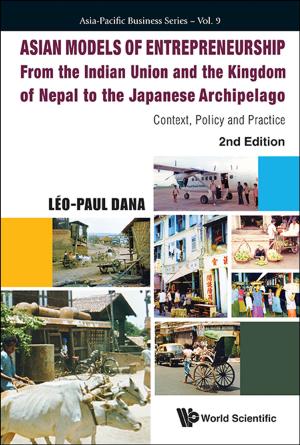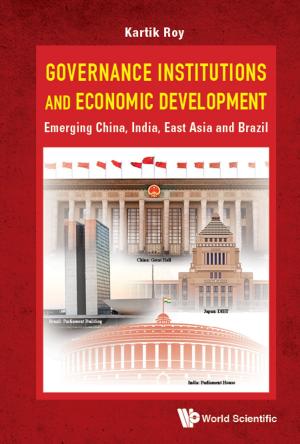Financial Reforms and Developments in China
Business & Finance, Economics, Money & Monetary Policy, Finance & Investing, Finance| Author: | Siwei Cheng | ISBN: | 9789814578691 |
| Publisher: | World Scientific Publishing Company | Publication: | November 1, 2013 |
| Imprint: | WSPC | Language: | English |
| Author: | Siwei Cheng |
| ISBN: | 9789814578691 |
| Publisher: | World Scientific Publishing Company |
| Publication: | November 1, 2013 |
| Imprint: | WSPC |
| Language: | English |
China has initiated and implemented its economic reforms for over 30 years, however, the comprehensive economic reforms and opening up is still unfolding. The author was a state leader, who has personally engaged in China's economic policy-making process from 1999 to 2008, and is an economist, who has deeply studied and thought over China's financial reform in various aspects. This book summarizes the results of the author's research on China's financial reforms, adopting the fictitious economy theory, in the past 10 years.
Financial Reforms and Development in China focuses on the developmental process and main features of the fictitious economy; the essence and the law of the fictitious capital (including credit capital, knowledge capital, social capital, etc.); the relationship between the fictitious economy and the real economy. The book attempts to use the fictitious economy theory to analyze the chaos and self-organization of financial system, financial crisis, inflation and deflation, economic globalization, and knowledge-based economy and society.
The book, comprising 12 chapters, covers all the main aspects of China's financial reform and provides readers with a practitioner's reading of China's financial markets, including financial globalization, the financial system and product innovation, financial crisis, financial security, financial regulation, universal banking, capital markets, money market, commercial banks, rural finance, futures markets, foreign exchange markets, financial derivatives, equity markets, insurance and so on.
The book is invaluable from the perspectives of its contribution to economic theory, in developing an understanding of the actual workings of China's economic and financial reforms in the past decade, and in forecasting future developments in China's economy and financial markets. It will appeal to academics, undergraduate students, graduate students, professionals, general readers interested in finance, the financial reform and market in China, as well as China's development and the fictitious economy.
Contents:
- Introduction: Finance from the Perspective of Fictitious Economy
- Financial Globalization and China's Financial Reform
- Causes of Deflation and China's Countermeasures
- Systematic Analysis and Proposals for Improvement and Modification of China's Stock Market
- Strategic Thinking about the Development of China's Money Market
- The Reform of China's State-Owned Commercial Banks: Objectives and Measures
- Seeking Effective Ways to Develop Chinese Rural Finance
- Status Quo and Prospects of China's Venture Capital Industry
- Analysis and Suggestions on Chinese Housing Reform
- Global Financial Crisis and the Strategy for China
- The Reform of RMB Exchange Rate System
- Conclusion: Three Directions for China's Financial Reforms
Readership: Academics, undergraduate students, graduate students, professionals, general readers interested in China's financial reform, financial market, China's development, fictitions economy.
China has initiated and implemented its economic reforms for over 30 years, however, the comprehensive economic reforms and opening up is still unfolding. The author was a state leader, who has personally engaged in China's economic policy-making process from 1999 to 2008, and is an economist, who has deeply studied and thought over China's financial reform in various aspects. This book summarizes the results of the author's research on China's financial reforms, adopting the fictitious economy theory, in the past 10 years.
Financial Reforms and Development in China focuses on the developmental process and main features of the fictitious economy; the essence and the law of the fictitious capital (including credit capital, knowledge capital, social capital, etc.); the relationship between the fictitious economy and the real economy. The book attempts to use the fictitious economy theory to analyze the chaos and self-organization of financial system, financial crisis, inflation and deflation, economic globalization, and knowledge-based economy and society.
The book, comprising 12 chapters, covers all the main aspects of China's financial reform and provides readers with a practitioner's reading of China's financial markets, including financial globalization, the financial system and product innovation, financial crisis, financial security, financial regulation, universal banking, capital markets, money market, commercial banks, rural finance, futures markets, foreign exchange markets, financial derivatives, equity markets, insurance and so on.
The book is invaluable from the perspectives of its contribution to economic theory, in developing an understanding of the actual workings of China's economic and financial reforms in the past decade, and in forecasting future developments in China's economy and financial markets. It will appeal to academics, undergraduate students, graduate students, professionals, general readers interested in finance, the financial reform and market in China, as well as China's development and the fictitious economy.
Contents:
- Introduction: Finance from the Perspective of Fictitious Economy
- Financial Globalization and China's Financial Reform
- Causes of Deflation and China's Countermeasures
- Systematic Analysis and Proposals for Improvement and Modification of China's Stock Market
- Strategic Thinking about the Development of China's Money Market
- The Reform of China's State-Owned Commercial Banks: Objectives and Measures
- Seeking Effective Ways to Develop Chinese Rural Finance
- Status Quo and Prospects of China's Venture Capital Industry
- Analysis and Suggestions on Chinese Housing Reform
- Global Financial Crisis and the Strategy for China
- The Reform of RMB Exchange Rate System
- Conclusion: Three Directions for China's Financial Reforms
Readership: Academics, undergraduate students, graduate students, professionals, general readers interested in China's financial reform, financial market, China's development, fictitions economy.















